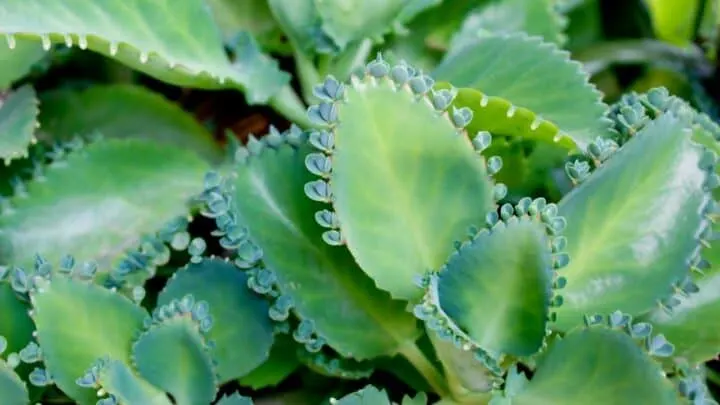You are here to read more about Kalanchoe pinnata, Mother of Thousands, and its care.
Kalanchoe pinnata
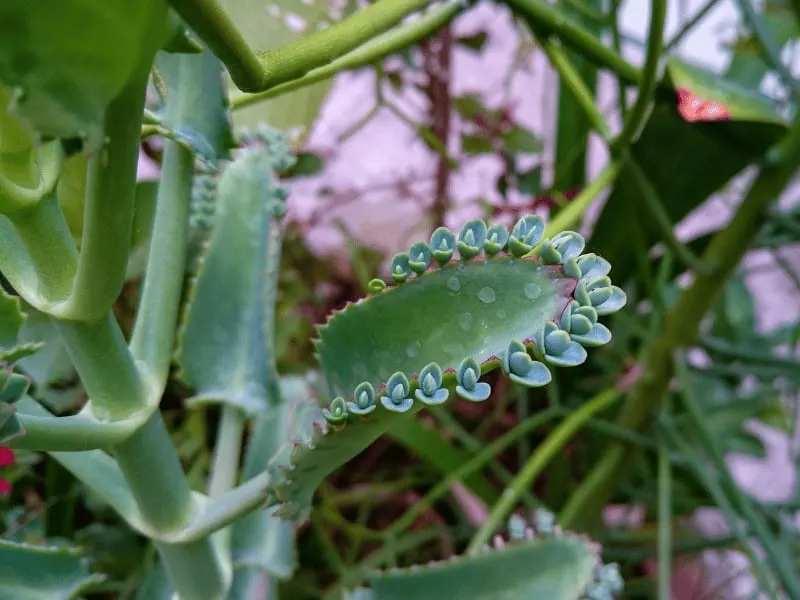
Kalanchoe pinnata, also commonly known as the Cathedral Bells plant, is a colorful succulent with sturdy stems and scalloped light-green leaves. When it blooms, it boasts bell-shaped purplish flowers that give it the name Cathedral Bells.
The plant has also earned the name Miracle plant or Life plant because of its widespread use in traditional medicine across different cultures.
Apart from its natural healing powers, Cathedral Bells make an excellent houseplant because of its unique look and colors.
Takeaways
| Species | Kalanchoe pinnata |
| Synonyms | Cathedral bells, air plant, life plant, miracle leaf, Goethe plant |
| Family | Crassulaceae |
| Genus | Kalanchoe |
| Growth | Upright, spreading |
| Height | 3.0 inches (7.6 cm) |
| Width | 3.0 inches (7.6 cm) |
| Soil | Well-draining soil mix |
| Watering | Every 7-14 days |
| Light | Bright indirect |
| Temperature | 60.0 - 85.0 °F (15.6 - 29.4 °C) |
| Humidity | 40.0 - 70.0 % |
| Fertilizer | Once a month |
| Propagation | Stem cuttings, leaf cuttings. |
| Toxicity | Toxic to humans, cats, and dogs. Contains cardiotoxic compounds. |
| Flower | Yellow flowers with purplish centers. They look like hibiscus flowers. |
Table of Contents
Kalanchoe pinnata care
Kalanchoe pinnata needs well-draining, sandy soil to grow well. It will thrive in a sunny spot with at least 6 hours of direct sunlight daily. It needs moderate water. Always wait for the soil to dry out before watering. Ideal growing temperatures are 60-85°F (15-30°C).
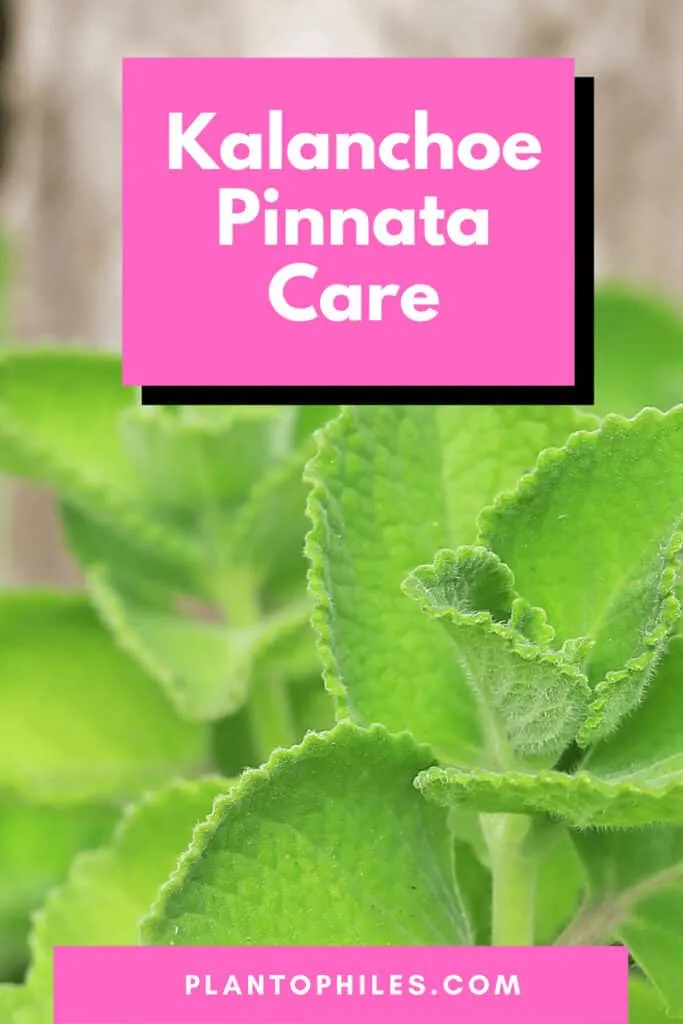
Cathedral Bells Plant Soil
Kalanchoe pinnata needs a well-draining but fertile soil mix to grow well. This plant will suffer in heavy soils and should not only be potted in regular garden soil. Using a succulent mix with some added organic compost is a good option. It can tolerate mildly acidic to mildly alkaline soil.
Kalanchoe Pinnata, or Cathedral Bells plant, is naturally found on the coast of Madagascar. It is most commonly found growing on sandy soils and near granite boulders.
Well-draining sandy soil is recommended to pot a Cathedral Bells succulent. This plant is highly drought-tolerant and can be grown for xeriscaping (plantations that require little or no irrigation).
Although using a succulent mix with some organic matter is the most straightforward solution, you could also prepare a DIY potting mix for this plant.
This is the recipe you can follow.
- 2-parts sand
- 1-part regular potting soil
- 1-part peat moss
- 1-part organic compost
Still, you could use a vast range of soil types to successfully grow Kalanchoe pinnata as it is, after all, a tough species.
But it all ultimately boils down to whether or not the soil is well-draining and well-aerated. If the two requirements are filled, 50% of your job as a Cathedral Bells owner is done.
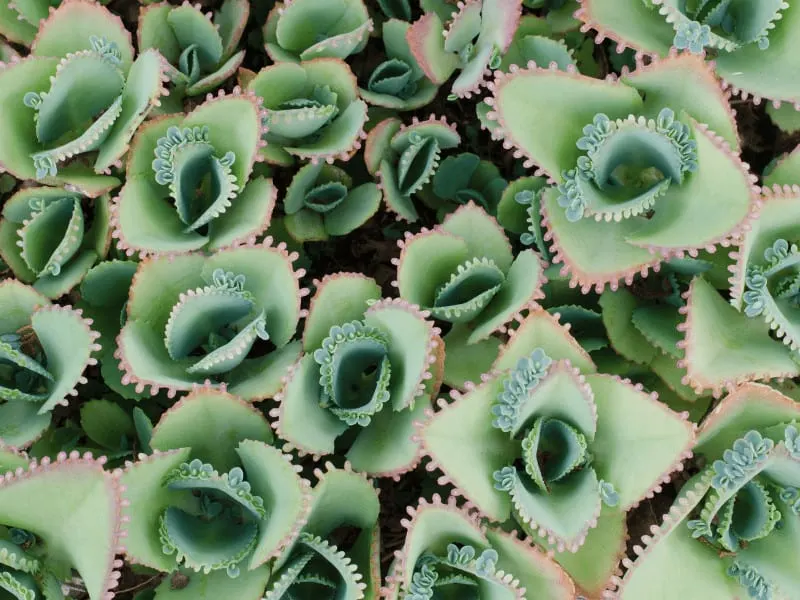
Light
Kalanchoe pinnata will thrive in a sunny spot with at least 6 hours of direct sunlight daily. This plant can also do well in bright indirect light but needs direct sunlight to bring out its red colors on leaf edges. Protect from intense sunlight in the summer as it can cause sunscald.
The fact that Cathedral Bells have a very light, green-colored foliage tells us that it has fewer amounts of chlorophyll in its leaves. It requires more sunlight to produce the same amount of energy for itself.
When growing outside, give this plant a spot where it can get bright sun all day in the winter. But in summer, protect the plant from harsh afternoon sunlight.
Kalanchoe pinata will also do well if grown indoors and gets direct sunlight for 3-4 hours daily. In the absence of adequate sunlight, growth will become leggy.
Your Cathedral Bells plant will become limp, and the distance between new leaf sets will increase in low-light conditions.
You might have to use a grow light to help this plant thrive when you bring it inside for the winter and it’s not getting adequate sunlight.
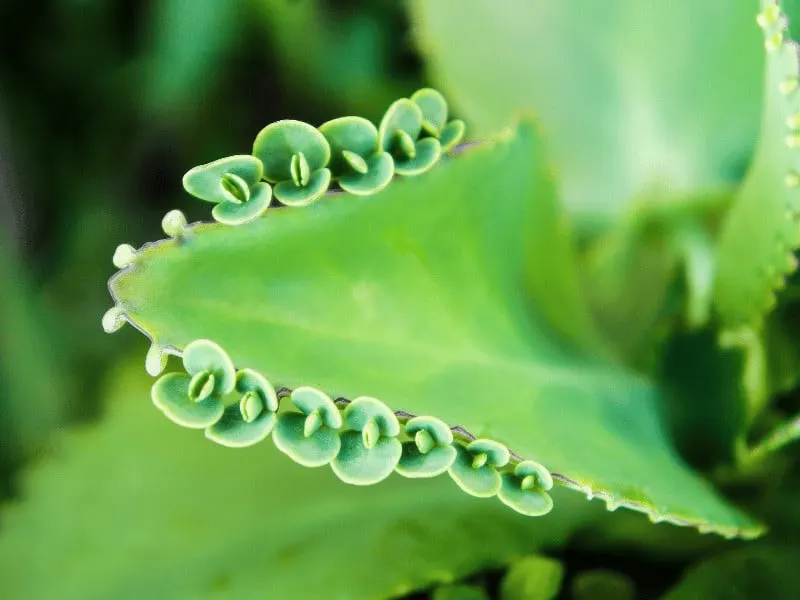
Watering
Water the Cathedral Bells plant every 7-14 days. Like all succulents, Cathedral Bells will need water in moderation. You should give this plant a good watering until water flows out from the drainage hole and always wait for the soil to dry out between watering. Overwatering or excess water getting stuck in the pot will lead to root rot.
The best method to water a Cathedral Bells plant is to follow the ‘Soak and Dry’ method. You water the plant well each time and then let the soil dry out before you water again.
Cathedral Bells is one of the succulents that can show signs of thirst when not watered for a long time.
The leaves start to wilt, and the normally erect stems look limp when the plant is underwatered. But don’t wait until your plant starts wilting to water it again.
Keep checking the surface of the soil for moisture. When the top few inches of the soil feel bone dry, it is time for watering.
The plant can stand over-watering for a long time before finally giving out. The stems become completely limp, and the long limbs bend in your shape.
Growth also becomes stunted when the plant is overwatered. If rescued, resilient plant species will return to health in a few weeks.
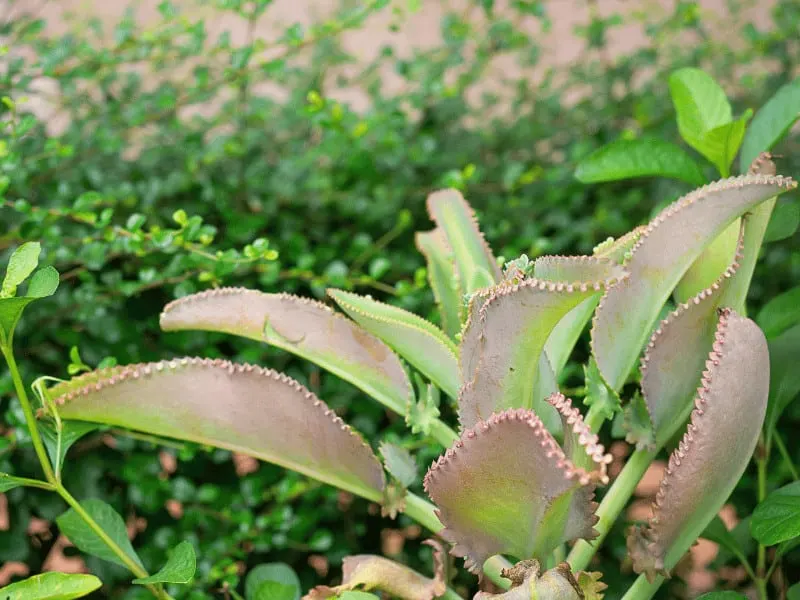
Goethe plant Temperature
The Goethe plant needs temperatures between 60-85°F (15-30°C). When growing in temperate climates, this plant must be grown in pots to be overwintered in the winter. Moreover, the plant can be grown outdoors year-round in USDA zones 9a-11b.
Compared to other succulents, the Cathedral Bells succulent has a relatively short ideal temperature range. This means they can neither do well in extremely low temperatures nor extremely high ones.
These plants will not survive frost or grow if temperatures fall below 50°F (10°C). In the same way, growth will get stunted, and the leaves may suffer sunscald when temperatures are too high.
Humidity
Cathedral Bells do not have particular humidity requirements to grow well and will do fine at average room humidity. They naturally grow in dry and rocky coastal areas with highly fluctuating humidity. It needs good ventilation and may develop powdery mildew in poor ventilation.
Most succulents native to the coast of Madagascar will do fine in any humidity level as long as there is good air ventilation.
These plans are not bothered if humidity falls too low as they have adequate water stored in their leaves. In the same way, high humidity does not do much good or harm to the plant.
However, when grown in high humidity conditions such as a greenhouse, the plant usually develops a case of powdery mildew.
The thick and flat leaves can cover each other up, creating perfect conditions for growing fungi. Keep the air around the plant ventilated to prevent powdery mildew.
Fertilizer
Kalanchoe pinnata, like all other Kalanchoe species, is not a heavy feeder and will not need you to fertilize it. If the potting medium contains adequate amounts of organic matter, the nutrients present in the soil are enough. Still, you could fertilize every month using a balanced fertilizer.
Fertilization is not an absolute must for succulents such as Cathedral Bells. You could also harm your plant by over-fertilization.
To encourage healthy and vigorous growth and a colorful Cathedral Bells plant, feed it every 40 days with mild doses of 20-20-20 balanced fertilizer.
Fertilizing the plant with organic compost is also a good option, but the nutrient takes quite a while to get absorbed in the soil.
On the other hand, you can have almost immediate results with water-soluble succulent fertilizer.
Growth
Mature Cathedral Bell plants can reach a height of up to 1.2 m when grown in the ground. Thanks to their sturdy stem, they can grow pretty tall in small pots. Leaves are thick and scalloped and with dark red edges. It produces reddish-purple bell-shaped blooms in spring.
Kalanchoe pinnata has thick, oval-shaped, serrated leaves. The leaves can vary from dark green to light green in color. Leaves are only found at the top end of each stem.
Each set of leaves has two growing opposite each other, and consecutive leaf sets grow in an X shape, crisscrossing each other. Leaf lengths can vary from 5 cm to 25 cm, while the width can range from 2 to 7 cm.
When provided the right amount of sunlight, leaves are light green, almost lime yellow, with dark red edges. The leaves have a remarkable ability to produce bulbils on their borders.
Bulbils are baby plants that can start growing from the leaf if the leaf falls on the ground. The bulbils on the leaf edges can sense soil moisture and then develop a root system in the soil.
This allows the Cathedral Bells succulent to reproduce asexually quite rampantly. The plants can cover a considerable amount of land growing laterally.
Potting
Cathedral Bell plants are best grown in clay pots with adequate drainage. Ceramic or plastic pots can be used, but soil compaction and inadequate drainage risk increases with these. This plant does not need very large pots. Small-medium sizes are fine.
All succulents, including Kalanchoe pinnata, need well-draining and well-aerated soil to stay healthy. But this is very hard to achieve when growing plants in plastic or ceramic pots.
The porous quality of clay pots allows healthy air exchange between the soil and the air. Another plus of using clay pots is that moisture can travel among the pores and make the outside of the pot feel cool to the touch when it is damp.
This will allow you to tell whether your plant has water immediately. Just feel the terra cotta pot; if it seems relatively cooler to touch, it does not need to be watered.
Adding a layer of pebbles or broken pot pieces to the bottom of the pot is an excellent practice to follow when potting Cathedral Bells.
Not only does it prevent the soil from falling to the ground and dirty your floor, but it also prevents the drainage hole from clogging.
Pruning
The Cathedral Bells succulent does not need frequent pruning. It usually grows neatly in an upright direction and will seldom outgrow its space. You should, however, prune off any damaged or dead leaves and remove spent blooms to encourage healthier growth.
Pruning Kalanchoe pinnata is a relatively straightforward process. This plant has a simple structure, and you will not have trouble finding what to prune and what not to.
Ensure you use sharp and clean shears so foreign pathogens do not infect the succulent. Remove damaged leaves flush from the stem and also remove spent blooms.
When placed in very low-light conditions, the plant starts leggy growth and can grow a long and limp stem. Sometimes this can give this plant a unique ‘literati’ style look.
A long and misshaped stem can also give an unsightly look, so it can be pruned off to encourage upright and bushy growth.
Kalanchoe pinnata Propagation
Kalanchoe pinnata is one of the easiest plants to propagate. They can be propagated either through leaves or stem cuttings. All you have to do is remove a full-grown leaf and lay it on soft and moist soil. In a few weeks, the bulbils will root and produce new plants.
Propagating Kalanchoe pinnata from leaves is much simpler than propagating through stems. But if you want a larger plant in a shorter time, propagating from stems is recommended.
New plants will sprout if a leaf falls anywhere with soft soil and a little soil moisture. That is all you need to do. Covering the leaf with soil is not recommended as it may rot.
On the other hand, there is a catch when propagating this plant from stems. When planted immediately in the ground, Kalanchoe pinnata will rot.
You should let the stems callus for a day or two after removing them and then plant them in soil for best results.
Common Problems with Cathedral Bells
Powdery Mildew
Your Kalanchoe pinnata may develop a case of powdery mildew if exposed to highly humid and poorly ventilated conditions.
Fluffy white patches may appear on the underside of leaves and stems. A mild Neem Oil spray a few times weekly will effectively address this problem.
Insects
Out of all Kalanchoe varieties, the Kalanchoe pinnata seems the tastiest to insects such as aphids, spider mites, and other insects that feed on foliage.
When planted outdoors, the Cathedral Bells plant may catch a case of insect infestation. Identify the pests on the underside of leaves first and act accordingly.
Conclusion
Cathedral Bells are easy to care for and add many unique colors to your plant collection.
All you have to do is keep it safe from being overwatered and give it ample sunlight, and sit back and enjoy it as it brightens up your garden with its glitzy colors and magnificent blossoms.
I hope this Kalanchoe pinnata care guide was helpful.

Daniel has been a plant enthusiast for over 20 years. He owns hundreds of houseplants and prepares for the chili growing seasons yearly with great anticipation. His favorite plants are plant species in the Araceae family, such as Monstera, Philodendron, and Anthurium. He also loves gardening and is growing hot peppers, tomatoes, and many more vegetables.

